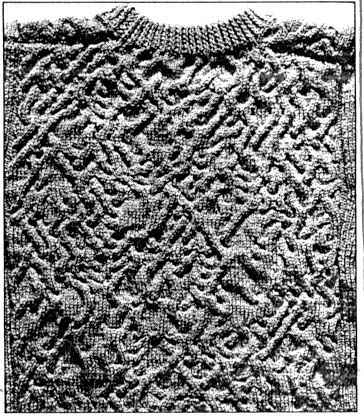
Mary Griffin with a beginner's guide to random knitting
New Scientist 26 March 1987
The idea of random knitting arose out of contact with polymer theoreticians and a desire to create an unusual two-dimensional representation of a random network. The prospect of a meeting on polymers stimulated the production of the pullover shown here. I have been encouraged to write a description of the design for the benefit of readers of New Scientist by colleagues and fellow commuters on the train, who were surprised to see me using a random number table as a knitting pattern.
The pullover shown was knitted from a standard pattern, with random network panels in the centre, front and back.

A cabling row is worked every four rows as follows. The pattern requires a list of random numbers. Each digit is read one by one and provides the instructions for the cabie. The key for the instructions is as follows:
Because of the difficulty in working out from the appearance of the work which number one has reached, it is advisable to mark this on the pattern, because repetition of a stretch of random numbers results in a non-random pattern. The pattern for the random network panel is therefore:
knit 1 row, *purl 1 row, knit 1 row, purl 1 row, cable 1 row using random number table*, repeat from * to * until the required length has been reached.
It will be immediately apparent that there will be end-effects, because, at the edges, a "half cable-stitch" is not possible. The practice that I adopted in making this pullover, which is not a solution to this problem, was to replace the desired "half cable-stitch" by knitting three stitches plain. Thus, if the pattern requires a cable stitch to be commenced on the last three stitches of the panel of random network, they are in fact knitted plain; the next cabling row is then begun with "knit 3" before resuming the pattern at the point where I left off at the end of the previous cabling row.
Developments in elementary particle physics suggest that the four fundamental forces may be described in a unified theory by regarding the elementary particles as "superstrings" existing in 10 dimensions. The two-dimensional analogue described above is readily deformed by the wearer so that gravity-like effects on the strings can be studied by personal inspection. This approach has been criticised by pedants as "woolly minded".
Mary Griffin is a physical scientist at the AFRC Institute of Food Research, Reading Laboratory. She knits in her spare time.